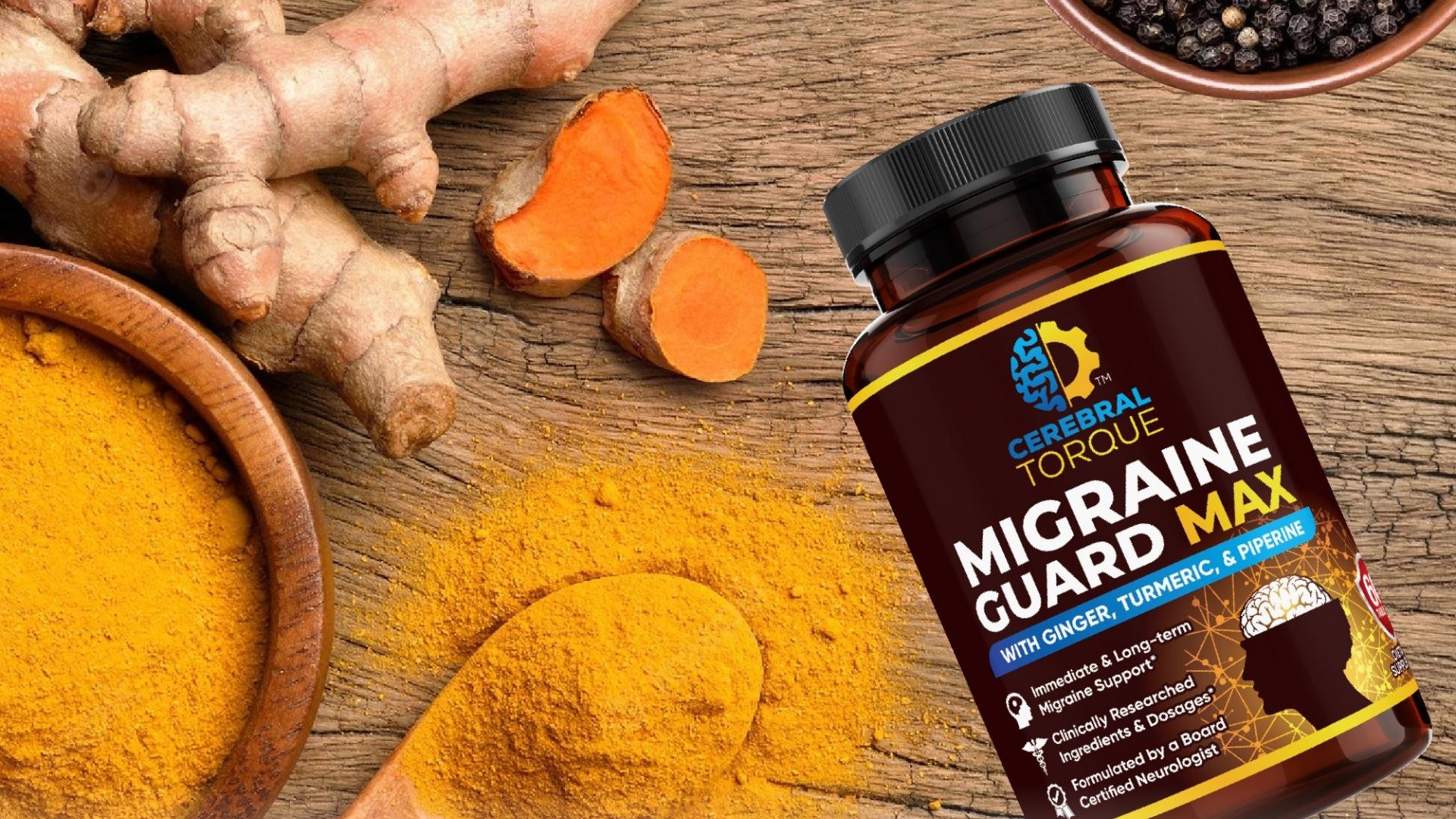Frequently Asked Questions*
What are the ingredients of Migraine Guard MAX?
Riboflavin 400 mg
Mix of Magnesium oxide and Mg citrate 500 mg
Feverfew Extract (10:1) 100 mg (Flower & stem)
Ginger Extract (10:1) 250 mg (Root)
Tumeric Extract (10:1) 200 mg (Root)
Black pepper extract 95% Piperine 10 mg (Fruit)
Why Riboflavin?
Studies show riboflavin reduces oxidative stress and inflammation of nerves, which are contributors to migraine headaches. Riboflavin is also needed to maintain normal mitochondrial activity and migraines are sometimes caused by mitochondrial abnormalities in the brain.
What do the studies show for Riboflavin?
Riboflavin Has Neuroprotective Potential: Focus on Parkinson’s Disease and Migraine
https://www.ncbi.nlm.nih.gov/pmc/articles/PMC5517396/
Effect of Vitamin B2 supplementation on migraine prophylaxis: a systematic review and meta-analysis
“A pooled analysis of available randomized controlled clinical trials demonstrated that Vitamin B2 400 mg/day for three months supplementation had significant effect on days, duration, frequency, and pain score of migraine attacks.”
https://pubmed.ncbi.nlm.nih.gov/33779525/
Did you catch that? 400 mg. Same as Migraine Guard MAX. And we test to make sure the potency is accurate!
Supplementation with Riboflavin (Vitamin B2) for Migraine Prophylaxis in Adults and Children: A Review
“It seems that riboflavin is a safe and well-tolerated option for preventing migraine symptoms in adults..."
https://pubmed.ncbi.nlm.nih.gov/26780280/
Prophylaxis of migraine headaches with riboflavin: A systematic review
"Riboflavin is well tolerated, inexpensive and has demonstrated efficacy in the reduction of adult patient's migraine headache frequency."
https://pubmed.ncbi.nlm.nih.gov/28485121/
High-dose riboflavin treatment is efficacious in migraine prophylaxis: an open study in a tertiary care centre
We could demonstrate a significant reduction of headache frequency following riboflavin treatment. In addition, the number of abortive anti-migraine tablets was reduced. In line with previous studies our findings show that riboflavin is a safe and well-tolerated alternative in migraine prophylaxis.
Why Magnesium?
Studies show that magnesium helps reduce the frequency, intensity, and duration of migraines. Research shows that individuals who suffer from migraines are more likely to have low levels of magnesium than those that do not. Research shows that magnesium is anti-inflammatory and helps stabilize nerve transmission, among many other potential benefits.
What do the studies show for Magnesium?
Magnesium is very well studied when it comes to migraines, especially with those that suffer from auras. The evidence shows effectiveness by allowing magnesium to essentially “stabilize” the brain. Studies also show that migraineurs have lower magnesium levels than the general population.
https://pubmed.ncbi.nlm.nih.gov/12010379/
This study shows that 500 mg of magnesium oxide appears to be as effective in migraine prophylaxis as valproate sodium [a prescription drug that may also be used for migraine] without significant adverse effect.
https://pubmed.ncbi.nlm.nih.gov/30798472/
The American Headache Society recommends a dose of 400-500 milligrams a day for magnesium oxide.
Migraine Guard Max, of course, has 500 mg of Magnesium oxide and citrate.
For a more in depth discussion on the science behind migraines and the role for magnesium prophylaxis, see:
Why did you source your magnesium from oxide and citrate?
While most of the studies use magnesium oxide, there seems to be an overwhelming amount of migraineurs that do better with citrate.
Moreover, magnesium citrate is the most bioavailable form of magnesium.
https://pubmed.ncbi.nlm.nih.gov/14596323/
Therefore, because Mg citrate is the most easily absorbed form of magnesium and evidence based medicine uses Mg oxide, we included both in Migraine Guard MAX.
Your ingredients say that you use a 10:1 extract for Feverfew, Ginger, and Turmeric. What does this mean?
That's correct. We use a 10:1 extract for our herbs. Our competitors, at best, will use a 4:1 or 5:1 extract. At worst, they won't use an extract at all. A 10:1 extract means that ten parts of the original plant went into producing just one part of the final extract. This results in a highly concentrated product. In Migraine Guard MAX, one teaspoon of powdered extract is the equivalent of using over three tablespoons of the whole herb! So the dosages we have listed correspond to the 10:1 extract, not just the herb. Don't let other companies trick you. If they don't have "extract" written then they're just using the whole herb- including the non-active components. Our powdered extracts are extremely potent and very shelf stable.
Why Feverfew?
Studies show feverfew reduces inflammation in blood vessels in the brain, which is believed to be one of the features of migraine pain. Feverfew may also decrease serotonin and prostaglandin levels thereby providing neurological support for the reduction of frequency and intensity of migraine attacks.
What do the studies show for Feverfew?
The most recent, rigorously executed randomized control trial found that feverfew demonstrated a decrease in migraine frequency of 0.6 attacks per month compared with placebo.
https://pubmed.ncbi.nlm.nih.gov/16232154/
Is it possible that there may be a synergistic effect when combined with the other ingredients? Maybe, but we won’t know until more studies are completed.
We do know that there appears to be a synergistic effect with ginger and feverfew.
Why don't you use Butterbur? I heard it helps migraines!
The American Academy of Neurology and the American Headache Society retracted recommendations for butterbur due to liver toxicity.
PA-free butterbur, like Petadolex, exists. This is considered a safer option, but there is evidence it still may cause liver toxicity.
Why Ginger?
Ginger has been shown, in clinical studies, to be as efficacious as sumatriptan for the ablative treatment of migraines, but with a better safety profile. Ginger has also been shown to help with nausea that is frequently associated with migraines. Aside from its researched anti-inflammatory and antioxidant properties, studies show that ginger also reduces a peptide called CGRP. CGRP is believed to cause the pain that migraineurs experience.
What do the studies show for Ginger?
Comparison Between the Efficacy of Ginger and Sumatriptan in the Ablative Treatment of the Common Migraine
“Two hours after using either drug, mean headaches severity decreased significantly. Efficacy of ginger powder and sumatriptan was similar. Clinical adverse effects of ginger powder were less than sumatriptan. Patients' satisfaction and willingness to continue did not differ. The effectiveness of ginger powder in the treatment of common migraine attacks is statistically comparable to sumatriptan. Ginger also poses a better side effect profile than sumatriptan.”
Maghbooli M, et al. (2014).
Comparison between the efficacy of ginger and sumatriptan in the ablative treatment of the common migraine. DOI: 10.1002/ptr.4996
The dose used for Ginger in this study is 250 mg, which is one serving of Migraine Guard MAX. Isn’t science great? Why can’t anyone get the dosages right? It’s okay. We have your back!
Ginger decreases calcitonin gene-related peptide (CGRP)- a contributor to the inflammatory process in migraine.
Source: https://pubmed.ncbi.nlm.nih.gov/27376323/
Ginger decreases oxidative stress.
Source: https://www.ncbi.nlm.nih.gov/pmc/articles/PMC3665023/
Migraineurs have elevated levels of oxidative stress and it is understood to be part of the pathogenesis of migraine.
Source: https://pubmed.ncbi.nlm.nih.gov/21518147/
Ginger reduces nausea and vomiting, which is part of the symptoms of migraine.
Why Turmeric?
Studies show that turmeric suppresses molecules known to play major roles in inflammation and that its antioxidant properties protect the body from free radicals. Turmeric has also been shown to boost levels of the brain hormone BDNF, which increases the growth of new neurons and may help fight various degenerative processes in your brain. This may also help alleviate depression, which may be more common in migraineurs, due to increasing BDNF.
What do the studies show for Turmeric?
Before you go on, you should know that turmeric's active component is curcumin. No, it’s not related to cumin. Although, they both are used in delicious Indian food.
Studies show turmeric has many benefits, but since this is a migraine supplement we will be brief:
https://www.mdpi.com/2304-8158/6/10/92
Turmeric has antioxidant and anti-inflammatory properties*, which, theoretically should therefore be beneficial for migraines.
Tumeric has also been shown in these next two studies to help migraine sufferers in concert with other supplements:
The Combined Effects of ω -3 Fatty Acids and Nano-Curcumin Supplementation on Intercellular Adhesion Molecule-1 (ICAM-1) Gene Expression and Serum Levels in Migraine Patients
https://pubmed.ncbi.nlm.nih.gov/29237386/
The synergistic effects of nano-curcumin and coenzyme Q10 supplementation in migraine prophylaxis: a randomized, placebo-controlled, double-blind trial
Why is the dose of Turmeric 200 mg?
Two reasons. A dose as high as 400 mg may actually cause headaches. A dose of 200 mg, like in Migraine Guard MAX, may help support the decrease the frequency and severity of migraine attacks. Secondly, we have piperine in ours. Turmeric isn’t absorbed well. Piperine increases the bioavailability of turmeric by 2000%. Therefore, the bioavailability of curcumin is increased by 20-fold thanks to piperine!
Why Piperine?
Piperine increases the absorption of curcumin, the active plant compound found in turmeric, by up to 2,000%. Turmeric alone is so poorly absorbed by the body that it is esentially useless without piperine.
What do studies show for Piperine?
As we stated in the answer to the last question, turmeric isn’t absorbed well. Piperine increases the bioavailability of turmeric by 2000%. Therefore, the bioavailability of curcumin is increased by 20-fold thanks to piperine!
This study shows that in the dosages used, piperine enhances the serum concentration, extent of absorption and bioavailability of curcumin in both rats and humans with no adverse effects.
https://pubmed.ncbi.nlm.nih.gov/9619120/
Enhanced bioavailability of curcumin was also evidenced by other research where curcumin was administered orally concomitant with piperine. Intestinal absorption of curcumin was also found relatively higher when administered concomitantly with piperine, and it stayed significantly longer in the body tissues.
I heard Vitamin D is good for migraines. Why don't you have Vitamin D?
Vitamin D is fat soluble. This means that it can become toxic in high doses. During the age of COVID, many people are regularly taking Vitamin D supplements in exceedingly high doses. We want everyone to be able to take Migraine Guard Max without the risk of developing Vitamin D toxicity.
I heard Alpha-Lipoic Acid (ALA) is good for migraines. Why don't you have ALA?
Alpha-Lipoic Acid or ALA is most commonly known for its use in patients with diabetic neuropathy.
In the most recent study evaluating ALA for migraines, it was found that "no significant changes were observed for NO levels and duration of migraine pains."
https://pubmed.ncbi.nlm.nih.gov/34997178/
Moreover, ALA was found to reduce the lifespan of mice.
https://pubmed.ncbi.nlm.nih.gov/22785389/
Healthy mice treated long-term with ALA developed hepatic steatosis and liver injury. The effect of long-term ALA supplementation in humans is currently unknown and, therefore, it is possible that similar negative effects could be observed.
https://pubmed.ncbi.nlm.nih.gov/26876280/
With the risk of shortening lifespan and causing injury, ALA does not factor into the equation with Migraine Guard MAX at all. We will continue to update our formula based on the latest research for the health, wellness, and safety of our customers.
Does Migraine Guard MAX work for menstrual migraines?
Migraine Guard MAX actively supports neurological health for menstrual migraine suggerers. For most females with migraines, the migraine occurs during the time of their menstrual cycle (2-3 days prior to 3rd day of flow). Migraines are NOT a normal part of the menstrual cycle and effective natural neurological support can be had with Migraine Guard MAX.
Research has shown that women with migraines during their menstrual cycle have magnesium deficiency.
https://pubmed.ncbi.nlm.nih.gov/12010379/
Moreover, because menstrual migraines occur due to a drop of estrogen, they will generally occur until menopause. Starting Migraine Guard MAX will provide you with the necessary magnesium that may support fixing disturbances in regional cerebral flow, cortical spreading depression, and oxidative stress.
Why is my urine more yellow when taking Migraine Guard MAX?
It's the Riboflavin. It's normal. No cause for alarm!

These statements have not been evaluated by the Food and Drug Administration. This product is not intended to diagnose, treat, cure or prevent any disease.*
